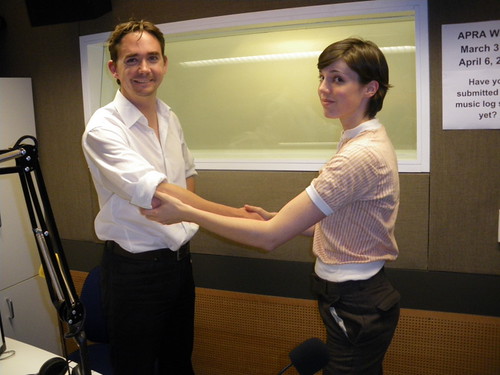 It may be an apocryphal tale, but here's an interesting story about how sailors of yore determined if a potential suitor had syphilis.
It may be an apocryphal tale, but here's an interesting story about how sailors of yore determined if a potential suitor had syphilis.As demonstrated by Victoria Bond and myself in the image on the right, Victoria is feeling my right elbow whilst shaking my hand. The epitrochlear lymph nodes in the elbow get swollen with syphilis.
The story goes that when sailors arrived in a new port, they would greet the girls in this manner to determine if they had syphilis. Another story goes that they did this whilst dancing. Whatever the case, it is true that the nodes swell when suffering from syphilis, although it's not fail safe as there are a number of things that could cause the swelling, including infection.
We made the following short video demonstration of the handshake when recording Diffusion Science Radio. The movie was produced by Ian Woolf. You can download the video as an mp4 here and find all my videos on youtube here.
While we're on the topic of syphilis, reports out of the UK this week are laying the blame for a rise in syphilis cases at the feet of social networking site Facebook. This story is the up there with the dangerous cookie story as one of the more stupid 'science' stories I have read. The Telegraph reported Facebook 'linked to rise in syphilis', however The Sun takes the cake with Sex diseases soaring due to Facebook romps.
The articles are based on an NHS news release titled Warning as syphilis cases increase. The news release does not mention Facebook, but does mention "social networking sites":
Professor Peter Kelly, Executive Director of Public Health for NHS Tees said syphilis has risen sharply in the last year.
"There has been a four fold increase in the number of syphilis cases detected with more young women being affected," he said. "Syphilis is a devastating disease which can lead to serious health problems to the infected individual, their sexual contacts and an unborn child (in pregnant women). It is easily preventable and treatment is simple and effective. Unprotected sex, especially with casual partners, is the biggest risk for syphilis. Social networking sites are making it easier for people to meet up for casual sex. It is important that people avoid high risk sexual behaviours and practise safe sex to protect themselves from sexually transmitted infections."
Syphilis cases have increased fourfold in Sunderland, Durham and Teesside. The UK newspapers, independent of the NHS press release, found that Facebook is very popular in Sunderland. The problem here of course is our old friend "correlation vs. causation" - it is in no way clear that Facebook (or more broadly online social networking) is connected to the rise in syphilis. Syphilis cases have been on the rise for some time now. And even if Facebook is increasing casual sex in these regions, should we really blame it for someone's sexual habits? Other problems include the fact that the sample size is tiny (30 people), there is no mention of other sexually transmitted diseases, and no actual evidence to connect social networking to syphilis is presented - it is a merely a comment. There is a good discussion of this at Bad Science.




















